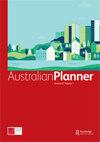Changing greenspace in residential developments in an inner suburb of Brisbane, Australia
IF 1.2
Q2 Social Sciences
引用次数: 3
Abstract
ABSTRACT The benefits of urban greenspace have been well researched and acknowledged in a strategic planning vision for Brisbane, Australia. As the world implements social distancing and home isolation in response to the COVID-19 pandemic, access to quality greenspace close to where people live may become more critical. This research investigated residential zoning code assessment benchmarks and development outcomes in terms of changing greenspace but found that the planning assessment process made analysis fraught and inaccurate. Nonetheless, the findings indicated that impact assessable development applications and approvals were not consistent with the stated policy objectives. Closer adherence to stated assessment benchmarks providing more generous setbacks, building separation and greenspace, could achieve the policy intent of higher-density development in a clean, green, sustainable city. The significance and implications of such findings has relevance for broader policy development, implementation and evaluation to improve governance through effective, efficient evaluation of policy outcomes. This study highlighted the imperative for demonstrable compliance with assessment benchmarks; and identified the need for future research into evaluation of planning policy implementation, to ensure outcomes comply with stated objectives. Further research is also required to understand the impact of, and future planning requirements for, residential greenspace. Highlights: Brisbane’s planning vision recognises the importance of greenspace provision. Development applications and approvals were not consistent with the stated policy intent. New development approvals had significantly reduced greenspace around sites. Public submissions had minimal impact on development approval outcomes. Planning policy evaluation requires consistent, measurable, enforceable assessment benchmarks.澳大利亚布里斯班内郊区住宅开发项目中不断变化的绿色空间
在澳大利亚布里斯班的战略规划愿景中,城市绿色空间的好处得到了充分的研究和认可。随着世界为应对COVID-19大流行而实施社交距离和家庭隔离,在人们居住的地方获得高质量的绿色空间可能变得更加重要。本研究从绿化空间变化的角度考察了住宅分区代码评估基准和开发结果,但发现规划评估过程使分析充满了担忧和不准确。尽管如此,调查结果表明,可评估影响的开发申请和批准与规定的政策目标不一致。更严格地遵守既定的评估基准,提供更慷慨的退让、建筑间隔和绿色空间,可以实现在一个清洁、绿色、可持续的城市中实现高密度发展的政策意图。这些发现的意义和影响与更广泛的政策制定、实施和评估有关,通过有效、高效地评估政策结果来改善治理。这项研究强调了必须证明遵守评估基准;并确定了未来需要对规划政策实施的评估进行研究,以确保结果符合既定目标。还需要进一步的研究来了解住宅绿地的影响和未来的规划要求。亮点:布里斯班的规划愿景认识到绿色空间提供的重要性。开发申请和批准与声明的政策意图不一致。新开发项目的批准大大减少了基地周围的绿色空间。公众意见对发展审批结果的影响微乎其微。规划政策评估需要一致的、可测量的、可执行的评估基准。
本文章由计算机程序翻译,如有差异,请以英文原文为准。
求助全文
约1分钟内获得全文
求助全文

 求助内容:
求助内容: 应助结果提醒方式:
应助结果提醒方式:


